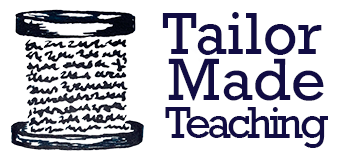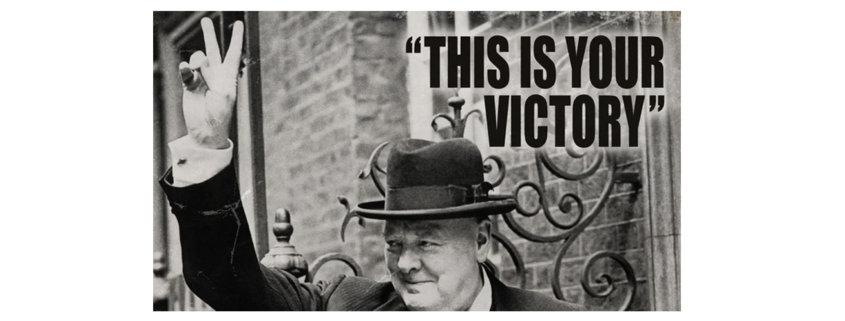
Gestures, Emojis and Language
I was working with a Chinese student the other day. She was talking about her upcoming school exams and I told her I’d ‘keep my fingers crossed’ for her. This caused a little confusion (Thank God she wasn’t Vietnamese!). This reminded me of the (many) times I’ve had to ask students to turn their palm towards me when indicating ‘two’ with their fingers in a V sign, and the various confusions I had when first living in Italy.
The UK doesn’t have as many gestures as Italians, but we do have some, and they do, occasionally, cause communication problems. Some gestures differ between English-speaking countries – Americans aren’t offended by the V sign, and, in my experience, tend to think it ‘cute’. Some gestures mean different things to different generations and in different social circles. But, it’s important to know if you are being offensive, or should take offence, in another culture. So, here is my guide to gestures used in the UK, how to refer to them in speech, how to portray them with emojis and what to avoid at all costs!
Common Gestures
‘(Keep my/your) Fingers crossed (for you/me)’
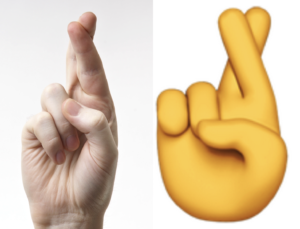 Meaning: Hoping for good luck for yourself or someone else. You can do the gesture without speaking, or you can say ‘Fingers crossed’ or ‘I’ll keep my fingers crossed (for you)’, ‘Keep your fingers crossed (for me)’, with or without the gesture.
Meaning: Hoping for good luck for yourself or someone else. You can do the gesture without speaking, or you can say ‘Fingers crossed’ or ‘I’ll keep my fingers crossed (for you)’, ‘Keep your fingers crossed (for me)’, with or without the gesture.
If you see someone doing this gesture behind their back when they are speaking, it means they are telling a ‘white lie’ (used humorously).
Examples in speech here.
‘(A) Thumbs up’
 Meaning: Good. In Iraq and Iran this is offensive (like the middle finger in English-speaking countries). Barbary apes have been observed using the gesture – we cannot be sure what they mean!
Meaning: Good. In Iraq and Iran this is offensive (like the middle finger in English-speaking countries). Barbary apes have been observed using the gesture – we cannot be sure what they mean!
Examples in speech here.
‘(A) Thumbs down’
 Meaning: Disapproval or refusal. In some countries it is considered rude or arrogant, in English-speaking countries, it’s quite neutral.
Meaning: Disapproval or refusal. In some countries it is considered rude or arrogant, in English-speaking countries, it’s quite neutral.
Examples in speech here.
‘(Give someone) A nod and a wink’
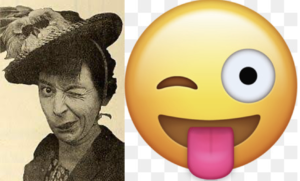 Meaning: Something is understood without saying it out loud. We often use the phrase to indicate that something is illegal or dishonest (we can’t talk about it, but everyone understands).
Meaning: Something is understood without saying it out loud. We often use the phrase to indicate that something is illegal or dishonest (we can’t talk about it, but everyone understands).
Examples in speech here.
‘(Give someone) The side eye’
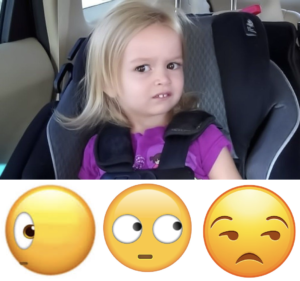 Meaning: Suspicion, disbelief, disapproval, skepticism. The Oxford English Dictionary notes the earliest known use of the phrase in print was in 1797 but the phrase has grown in popularity in more recent years.
Meaning: Suspicion, disbelief, disapproval, skepticism. The Oxford English Dictionary notes the earliest known use of the phrase in print was in 1797 but the phrase has grown in popularity in more recent years.
Examples in speech here.
‘It’s a head scratcher’
 Meaning: Something is confusing or puzzling. We generally use the phrase rather than the gesture. It is almost always used as a noun phrase.
Meaning: Something is confusing or puzzling. We generally use the phrase rather than the gesture. It is almost always used as a noun phrase.
Examples in speech here (not the first example which is purely descriptive).
‘Time Out’
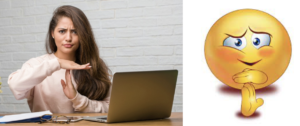 Meaning: Suggest a break. This originated in several American sports (basketball, American football, soccer and ice hockey).
Meaning: Suggest a break. This originated in several American sports (basketball, American football, soccer and ice hockey).
‘(Give someone a) High Five’
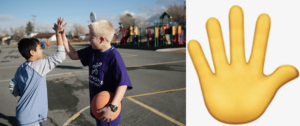 Meaning: Celebration or greeting. This has spread to the UK from America.
Meaning: Celebration or greeting. This has spread to the UK from America.
Examples in speech here.
‘Rock on’
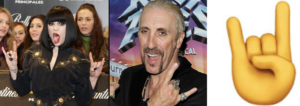 Associated with rock music, excitement and enthusiasm. The phrase, ‘Rock on’, is often said at the same time as doing the gesture. It originated in Italy as an offensive gesture which suggests a man is being cuckolded.
Associated with rock music, excitement and enthusiasm. The phrase, ‘Rock on’, is often said at the same time as doing the gesture. It originated in Italy as an offensive gesture which suggests a man is being cuckolded.
Example here.
‘A Fist Bump’
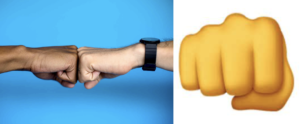 Meaning: Greeting, respect, agreement. This is similar in meaning to a handshake or high five but much less formal than a handshake and less enthusiastic than a high five.
Meaning: Greeting, respect, agreement. This is similar in meaning to a handshake or high five but much less formal than a handshake and less enthusiastic than a high five.
Examples in speech here.
‘Okay’
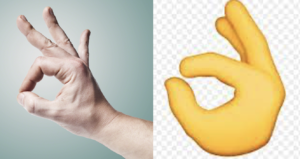 Meaning: Okay. In most English-speaking countries this shows approval or agreement. It’s also used in scuba diving to signal that someone is okay, or ask if someone is okay, underwater. However, it has wildly different meanings in different cultures around the world.
Meaning: Okay. In most English-speaking countries this shows approval or agreement. It’s also used in scuba diving to signal that someone is okay, or ask if someone is okay, underwater. However, it has wildly different meanings in different cultures around the world.
Money
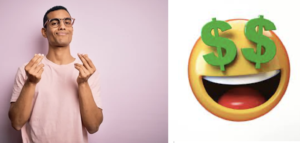 Meaning: Lots of money, pay me or expensive. This is a gesture, rather than a phrase. It’s made by repeatedly rubbing the thumb and forefinger.
Meaning: Lots of money, pay me or expensive. This is a gesture, rather than a phrase. It’s made by repeatedly rubbing the thumb and forefinger.
‘So-so’
 Meaning: neutral emotion (‘so-so’) or mild dissatisfaction (‘meh’) or uncertainty (‘ish’). This gesture is made by rocking the hand from side to side. The gesture can be used by itself or used with (or replaced by) one of the words in brackets above, depending on meaning.
Meaning: neutral emotion (‘so-so’) or mild dissatisfaction (‘meh’) or uncertainty (‘ish’). This gesture is made by rocking the hand from side to side. The gesture can be used by itself or used with (or replaced by) one of the words in brackets above, depending on meaning.
Examples of ‘meh’ in speech here.
Examples of ‘ish’ in speech here.
“Shh”
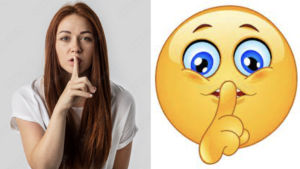 Meaning: Be quiet/Hush. I imagine this is a universal gesture although the ‘shh’ sound is not the same in every language.
Meaning: Be quiet/Hush. I imagine this is a universal gesture although the ‘shh’ sound is not the same in every language.
Examples of ‘shh’ in speech here.
Tap the side of your nose
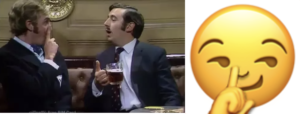 Meaning: It’s secret, don’t tell anyone. We don’t have a phrase to describe this gesture. You usually just tap the side of your nose twice. It probably comes from the phrase ‘keep your nose out of someone’s business’ or ‘don’t be nosy’. It’s more common in the UK than in America.
Meaning: It’s secret, don’t tell anyone. We don’t have a phrase to describe this gesture. You usually just tap the side of your nose twice. It probably comes from the phrase ‘keep your nose out of someone’s business’ or ‘don’t be nosy’. It’s more common in the UK than in America.
“Crazy”
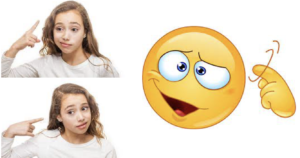 Meaning: You are crazy. This gesture is made by swirling your finger near the side of your head (your temple). A lot of cultures tap the side of the head to mean someone is crazy, but that can mean ‘clever’ in English-speaking countries.
Meaning: You are crazy. This gesture is made by swirling your finger near the side of your head (your temple). A lot of cultures tap the side of the head to mean someone is crazy, but that can mean ‘clever’ in English-speaking countries.
Pointing
 ‘It’s rude to point’ directly at someone, as it is in most cultures.
‘It’s rude to point’ directly at someone, as it is in most cultures.
Shrugging
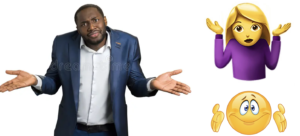 Meaning: I don’t know and/or I don’t care.
Meaning: I don’t know and/or I don’t care.
Offensive Gestures
‘Flip the bird’ (American English) ‘(Give someone) The (Middle) Finger’ (British English)
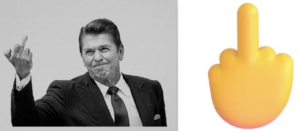 Meaning: ‘Up yours’ or ‘Fuck you’. This is common in both the US and the UK.
Meaning: ‘Up yours’ or ‘Fuck you’. This is common in both the US and the UK.
The V sign
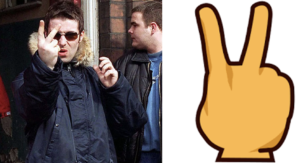 Meaning: The same as the middle finger. This is only really used in the UK and is less common now. This is commonly used in other cultures to signal the number ‘two’, I often have to explain to students to turn their palm around or avoid it completely in the UK.
Meaning: The same as the middle finger. This is only really used in the UK and is less common now. This is commonly used in other cultures to signal the number ‘two’, I often have to explain to students to turn their palm around or avoid it completely in the UK.
Loser
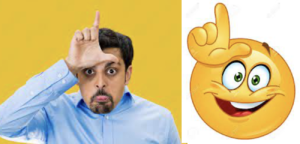 Meaning: You’re a loser. This is not so commonly used these days, or used humorously, and so not as offensive as it was originally meant to be.
Meaning: You’re a loser. This is not so commonly used these days, or used humorously, and so not as offensive as it was originally meant to be.
Political Gestures
The Victory / Peace Sign
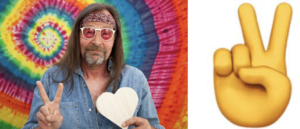 Meaning: Victory or Peace. This is quite universally understood. Note that the palm is facing outwards (don’t confuse it with the V sign).
Meaning: Victory or Peace. This is quite universally understood. Note that the palm is facing outwards (don’t confuse it with the V sign).
The Raised Fist
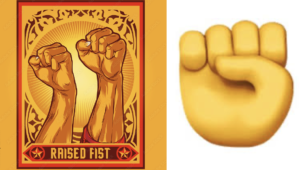 Meaning: Solidarity or Resistance. This originated with the International Liberation Movement in the early 20th century, it’s been used by anti-fascist and liberation movements across the world.
Meaning: Solidarity or Resistance. This originated with the International Liberation Movement in the early 20th century, it’s been used by anti-fascist and liberation movements across the world.
The Nazi Salute
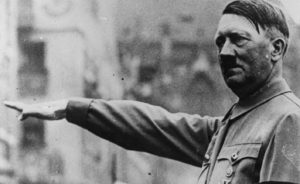 A gesture to be avoided.
A gesture to be avoided.
Changing Gestures
‘Call me’
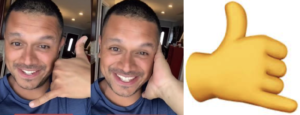 Many people have reported in recent years that children who’ve grown up with mobile phones don’t understand the ‘call me’ gesture made with thumb and little (pinky) finger extended. Instead, they use a flat palm against their face. I’ve not seen this in the wild yet.
Many people have reported in recent years that children who’ve grown up with mobile phones don’t understand the ‘call me’ gesture made with thumb and little (pinky) finger extended. Instead, they use a flat palm against their face. I’ve not seen this in the wild yet.
Posh way to drink tea
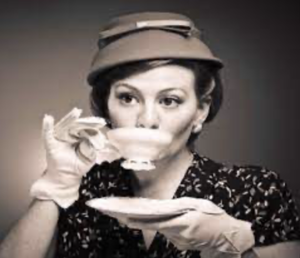 At one point it was considered posh, in the UK at least, to drink tea with your little (pinky) finger extended. These days it is most often used humorously or sarcastically.
At one point it was considered posh, in the UK at least, to drink tea with your little (pinky) finger extended. These days it is most often used humorously or sarcastically.
White Power
 News reports suggest that the Okay symbol has been taken by various fascist, racist, organisations to indicate ‘White Power’, usually with the hand pointed downwards. In general though, when not performed in company of racists and/or fascists, it’s still understood to mean okay.
News reports suggest that the Okay symbol has been taken by various fascist, racist, organisations to indicate ‘White Power’, usually with the hand pointed downwards. In general though, when not performed in company of racists and/or fascists, it’s still understood to mean okay.
Violence at Home
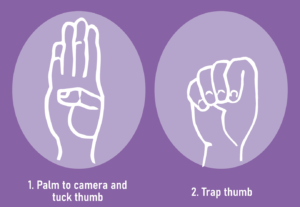
Introduced in 2000 by a Canadian Woman’s group, this gesture has spread on social media in recent years as a way of indicating that someone needs rescuing. It’s a continuous hand movement, used when someone cannot speak. It signals that the person someone is with is violent and they need help. If you see someone making this gesture, you should seek help or call the police.
Extra information here.
Have you ever experienced a miscommunication using a gesture? Are there any common gestures you find confusing?
